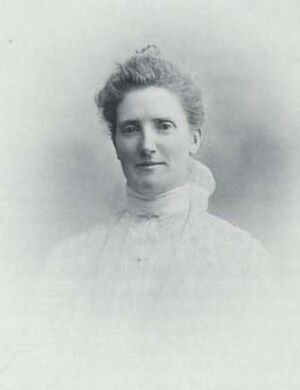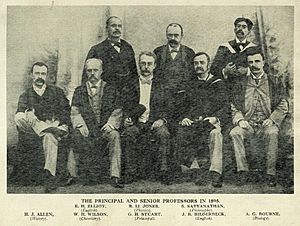Alfred Gibbs Bourne facts for kids
Quick facts for kids
Alfred Gibbs Bourne
|
|
|---|---|
 |
|
| Born | 8 August 1859 |
| Died | 14 July 1940 |
| Scientific career | |
| Fields | Zoology, Botany |
| Institutions | Presidency College, Madras Indian Institute of Science |
Sir Alfred Gibbs Bourne was an important English scientist and teacher. He was born on August 8, 1859, in Lowestoft, England, and passed away on July 14, 1940, in Dartmouth, Devon. He was a zoologist, which means he studied animals, and a botanist, someone who studies plants. Sir Alfred spent a big part of his life working and teaching in India.
Early Life and Education
Alfred Gibbs Bourne grew up in a family that valued learning. His father, Reverend Alfred Bourne, was the secretary of the British Foreign School Society, an organization that helped set up schools. Alfred received much of his early education at home. Later, he attended the University College School.
While studying, Alfred became very interested in science. He was especially inspired by the lectures of Ray Lankester, a famous zoologist. In 1876, Alfred continued his studies at University College London and also attended the Royal School of Mines. These experiences helped him become an expert in biology.
Work in India
In 1886, Alfred Gibbs Bourne moved to Madras (now Chennai) in India. He became a Professor of Biology at Presidency College. He held this important teaching job until 1898. During his time there, he also took on other roles, like being the Registrar and Superintendent of the Madras Government Museum. A registrar helps manage student records, and a superintendent oversees a place or department.
In 1895, Alfred Bourne was recognized for his scientific work. He was chosen to be a Fellow of the Royal Society. This is a very high honor for scientists in the United Kingdom.
In 1903, Sir Alfred took on a new role as the Director of Public Instruction. This meant he was in charge of public education in the region. He worked hard to improve the secondary education system. He helped introduce the Secondary School Leaving Certificate System, which was a new way to certify that students had completed their high school education.
After retiring from his role in public instruction, he continued to contribute to science and education. From 1915 to 1921, he served as the director of the Indian Institute of Science. This is a leading university for science and engineering in India. In 1913, he was honored by the British government and became a Knight Commander of the Order of the Indian Empire, which is why he is known as "Sir" Alfred.
Family Life
Alfred Gibbs Bourne married Emily Tree Glaisher in 1888. She was also a talented artist, especially known for her botanical drawings. Botanical artists draw plants with great detail and accuracy. Lady Bourne, as she was known, worked with other artists in Kodaikanal, a hill station in India. Together, they created beautiful illustrations of the local plants. These drawings were later used in a book called The Flora of the Nilgiri and Pulney Hill-tops, written by Philip Furley Fyson. Alfred and Emily had a daughter who later married Stephen Cox, who worked for the Indian Forest Service.



